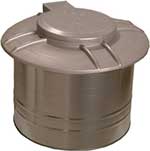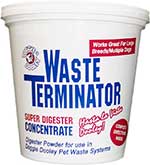Have you ever taken a moment to consider just how much dog poop you're picking up every day? It's a lot! Depending on your dog's size, they could be producing nearly a pound of waste a day. That's a couple of hundred pounds a year!
Scooping dog poop is one of those dreaded tasks no one wants to do. However, we suck it up and do it anyway to keep the yard clean and safe.
But what if scooping wasn't your only option?
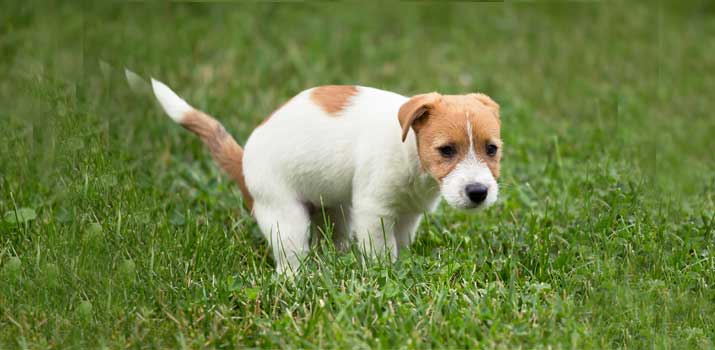
Believe it or not, there are some alternatives to getting rid of dog poop. These options eliminate the need for traditional disposal. Not only are they more convenient, but they may be better for the environment and your wallet!
5 Ways to Get Rid of Dog Poop without Scooping
#1. Using a Vacuum or Automatic Scooper
If you're not a fan of traditional scoopers or picking up poop by hand, you can use a vacuum. These products are not as widespread as old-school poop bags. But, they can be a real life-changer for some!
The concept of a vacuum or automatic scooper is pretty simple. These gadgets look like standard handheld vacuums. A small motor creates enough suction to lift the waste off the grass and into a small repository.
I know what you're thinking: Who wants to empty a poop canister?
Well, most poop vacuums have a disposable bag liner. Think of it as an airtight vacuum bag. The poop goes into the plastic liner, making it easy to tie off and dispose of.
You don't have to see or smell the poop at all once it gets into the vacuum! It's a win-win!
#2. Hose and Dilute
Here's a disposal technique that many dog owners try at some point.
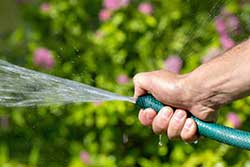
Rather than picking up the waste, you can blast it with the hose! Doing so will break the solids up and dilute the rest. This method isn't perfect.
There's still the risk of pathogens and bacteria spreading on your lawn. But, it does address the issue of natural biodegradation.
You see, poop will break down on its own with time. However, it releases high amounts of nitrogen in the process. The nitrogen will make its way to the soil, which will make the area highly acidic.
Excess nitrogen will also burn plants, resulting in noticeably yellow spots.
Related:
Hosing the waste down eliminates that issue a bit. You're diluting the waste, making it easier to break down naturally without turning into a concentrated spot of nitrogen.
The microorganisms in the poop can flourish beneath the soil, which may benefit your plants in the long run.
There are some risks involved with this technique due to potentially harmful bacteria. But it may be a viable option if you're in a pinch.
#3. Dissolving the Poop
This method for getting rid of dog poop in the yard is pretty similar to the previous one. But instead of using water, you're using the power of natural enzymes to dissolve the waste into nothing!
As mentioned earlier, poop breaks down on its own. The natural microorganisms in the soil will take care of the process. However, it takes a lot of time. Controlled dissolving is quicker and more efficient.
Dissolving poop involves beneficial enzymes. These enzymes target waste. They can even eliminate potentially harmful bacteria, returning the constituents of the waste to the earth as fertilizer.
Think of it as doing the work of a septic tank or waste processing plant. The same concepts apply on a larger scale in waste management services. But here, you're doing things quickly and efficiently to keep your yard looking clean!
- What Dissolves Poop in the Yard?
To successfully dissolve dog waste, you need the proper enzymes.
If you're in a pinch, you can use vinegar. Vinegar is a natural antiseptic that has antimicrobial and antibacterial properties. It's an acid that will eradicate odor-causing bacteria, too.
The problem, however, is its efficiency. Vinegar is nowhere near as effective as full-blown enzyme solutions. Not only that, but it may burn your grass and plants.
You can use vinegar when you have nothing else on hand. But for the best results, stick to commercial dissolving enzymes! Here's one of our favorites.
* Microbe-Lift Outdoor Yard Odor Eliminator
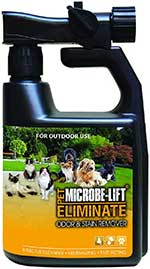
This product is marketed as an odor eliminator, but its efficiency goes much deeper. It uses powerful enzymes to break down waste into carbon dioxide and water!
The formula gets rid of all the nasty stuff like odors and solids.
All the while, it gets rid of bacteria to make your lawn a little safer. Best of all, it's all-natural and safe on your plants!
#4. Dedicated Dog Waste Septic Tanks
Want a more permanent solution to your dog poop problems? If so, consider installing a septic system!
Canine septic tanks operate pretty similarly to human-grade systems. They're comprised of an underground container that promotes the waste's natural decomposition.
They're closed-off systems that work with natural processes to eliminate waste.It's a much safer alternative to surface-level decomposition or burying the poop.
When you bury the waste, the potentially harmful constituents can still leach into the soil. With a canine septic tank, that's not something you have to worry about.
Most of the tank is hidden under the ground. The only thing you'll see is a small access door! They feature airtight lids that are discrete and secure.
All you have to do is plop the waste in, add some digesting enzymes, and let Mother Nature take its course!
Dog Septic System and Digester Formula
Dog septic tanks are a niche product, but they're pretty accessible to the average dog owner. Like any other septic system, maintenance and proper setup are key!
To get rid of dog poop without scooping, you need the septic tank itself and the digester enzymes.
Doggie Dooley Septic Style Dog Waste Disposal System
Doggie Dooley is one of the leading names in canine waste disposal. This septic system is made of heavy-duty galvanized steel. It comes fully assembled with an overflow tube and a polyethylene lid.
Once you install it according to the instructions, using it is a cinch. Just drop the waste in and add the digester about once a week to keep the decomposition process going.
Doggie Dooley Waste Terminator Powder
Also from Doggie Dooley is this digester powder. It contains all the beneficial enzymes you need to keep the septic system in good shape. The enzymes are safe and surprisingly efficient! They get to work almost instantly!
#5. Composting
Finally, there's composting. Composting dog waste is a big point of contention among dog owners. Some vehemently disagree with the technique, stating that it can lead to potential pathogen problems. However, others say that it's acceptable and beneficial to your garden!
If you're on the fence, turn to the United States Department of Agriculture. Believe it or not, the USDA has tons of literature regarding the act of composting dog waste!
The USDA provides guides that show you how to get rid of dog poop safely and efficiently.
It involves using a lot of nitrogen-rich material like grass clippings and vegetable scraps. When done correctly, you can create some excellent organic fertilizer for your garden!
We recommend doing some research beforehand to ensure that you're going everything safely.
Conclusion
You don't have to resort to poop bags and hand-scooping! These dog poop disposal methods offer a more natural alternative to tossing waste.
While they are a little more involved, these techniques can do a lot to help the environment and your wallet. Give them a try and see which one works best for you!


